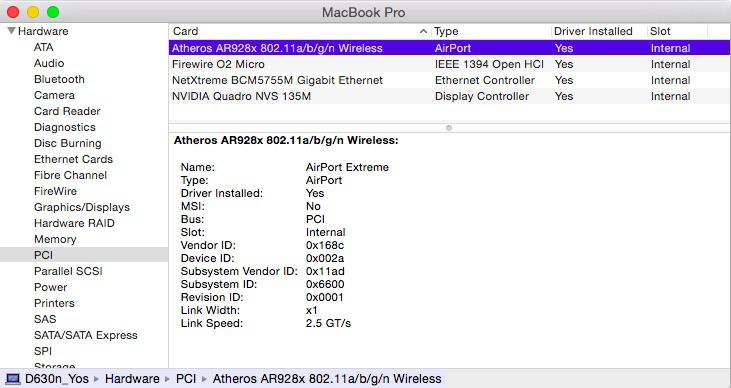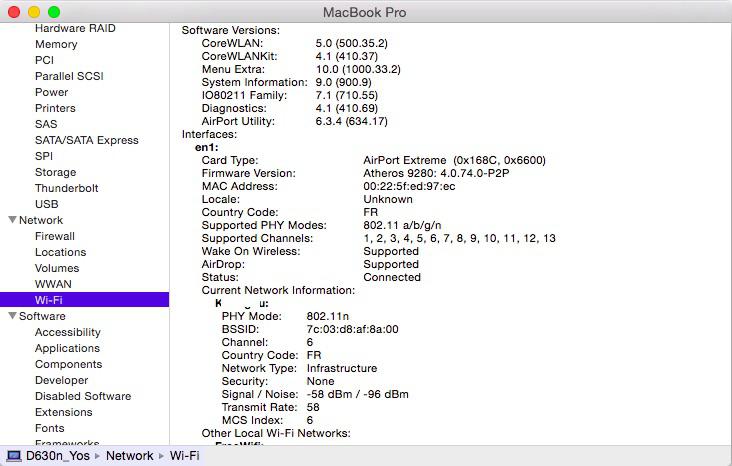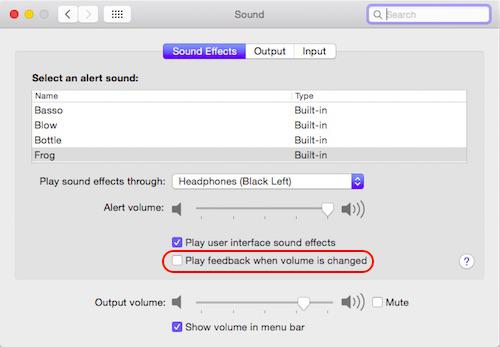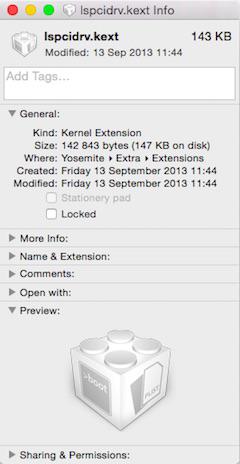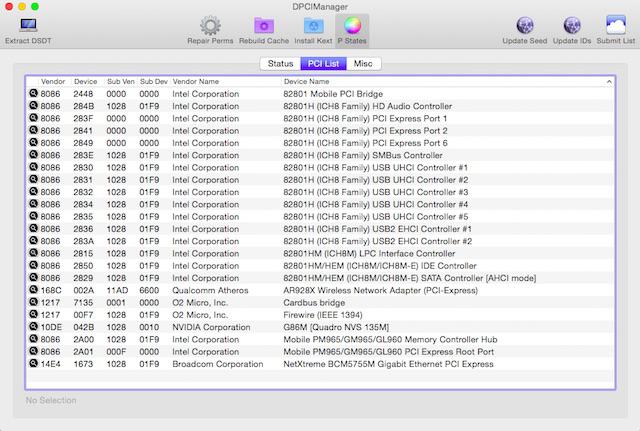-
Posts
10068 -
Joined
-
Last visited
-
Days Won
569
Content Type
Profiles
Articles, News and Tips
Forums
Everything posted by Hervé
-
You don't need a battery to update your BIOS. Download the executable package of one of the latest versions (A17 to A19) off Dell's web site and extract the .HDR file using DOS command <BIOS Filename>.exe -writehdrfile. Then, place the file on a USB key and follow the procedure to update the BIOS (power cable out, battery out, keep End key down, plug power cable, release End key after 2 seconds). This procedure has been detailed elsewhere in the forum (in D430, D6x0 or M4300 threads) and on the Net. Look up for BIOS recovery on Dell laptops. I would not use EDP if I were you (it's been causing far too many problems on older Dell laptops for too long now), stick to the initial boot pack and look for the final packs I posted here and there in D6xx section.
-
Guys, please, this section is for myHack installations. As this is not the case here, please move your thread to the E Series support section. Is it that difficult to have a little discipline on the forum at all?
-
myHack does not support Yosemite. Please post your thread in the E Series support section.
-
Use the attached pack. The kext goes to /Extra/Extensions, the plist files to /Extra and the HWMonitor app to /Applications. Run myFix (quick) to install the kext. You may adjust the GraphicsMode of the boot plist to your own LCD resolution if you want. D830n_tuning.zip Also ensure that IDA is not enabled in BIOS (necessary if running on a Merom CPU, which the T7800 is). In terms of kexts in /E/E, all you really should have is: AppleACPIPS2Nub.kext AppleHDADisabler.kext ApplePS2Controller.kext BCM5722D.kext FakeSMC.kext Patched_10.7_AppleRTC.kext VoodooBattery.kext VoodooHDA.kext lspcidrv.kext
-
Off topic, please create your own thread in the support section.
-
All the necessary laptop hardware documentation is provided in the Service Manual available at Dell's support web site.
-
SMB connections do not work under MLPF, it's one of the bugs/limitations.
-
If you're installing OS X on an MBR partitioned disk, yes you need the MBR patch. myHack normally prompts for it at the end of the installation. The target partition must be formatted Mac OS X Extended (journaled) through Disk Utility before you begin installation.
-
I guess you may not have read that guide with sufficient attention. I really thought I was clear enough... Clover is able to extract the kernel automatically, Chameleon is not. That is why I spoke of Chameleon at 1st reboot step, i.e. after OS installation, not at USB installer initial boot step. This being said, if you're using a Chameleon based Yosemite USB installer, you can always copy the kernel as mach_kernel at the root of the USB key or as kernel in /System/Library/Kernels folder. That will work. Yosemite_kernel_(10.10_10.10.1).zip
-
This AR9285-based card requires a simple patch of the Atheros40 kext to work. What did you do exactly?
-

[Guide] Dell Latitude E6430 with Yosemite 10.10 (14A389)
Hervé replied to dunghv's topic in The Archive
I think Yosemite is more buggy than expected. Since I've updated my D630n to the latest 10.10.2 Beta, sometimes, whilst in the middle of something, I get bombed out and back to the login screen with username/password prompts. System will then freeze on login attempt, I have to reboot. I'm glad I kept my Mavericks partition... -
There's a Mavericks /Extra for the E6320 in the Supported Models with Guides section and in other threads. The CPU-specific item is the SSDT. What you should do is remove the SSDT from the packs, then create your own using the well-known script. Alternatively look for your specific CPU SSDT on the Net, other sites have substantial lists of ready-made Intel "i" Core CPU SSDT files.
-

Inspiron 3542 has a problem with adjusting brightness
Hervé replied to nareto's topic in The Archive
http://ark.intel.com/products/75105/Intel-Core-i3-4005U-Processor-3M-Cache-1_70-GHz Do you have full graphics acceleration? -
Ok, so half-size mini-PCIe Foxconn T77H047.31 (Atheros AR5B93) card based on Atheros AR9283 chip.
-
Could be a channel issue if those 802.11n networks operate on channels beyond 11. If you can, check which channels these networks operate on. It was not the case for my own Atheros AR5B91 (a Lite-On WN6600A model), but I had to change the channel that my home wireless network ran on by default to get an 802.11n USB dongle to work properly. My Atheros AR5B91 wireless card supports channels up to #13. -> In SysProfiler/Hardware/PCI: -> In SysProfiler/Network/Wi-Fi (if you wonder about the software versions, please note that I'm up to latest 10.10.2 Beta): I would suggest you check the exact card model. I could not definitely identify it according to the registered information on wikidevi. It's probably the Foxconn T77H047.31. There seems to be discrepancies between Subsystemid (0xE01F) and OUI (0c:60:76), though the wiki could be incomplete of course. You should also verify your antennas connection. https://wikidevi.com/wiki/Special:Ask?title=Special%3AAsk&q=%5B%5BVendor+ID::168c%5D%5D+%5B%5BDevice+ID::002a%5D%5D&po=%3FInterface%0D%0A%3FFCC+ID%0D%0A%3FManuf%0D%0A%3FManuf+product+model=Manuf.+mdl%0D%0A%3FVendor+ID%0D%0A%3FDevice+ID%0D%0A%3FSubvendor+ID%0D%0A%3FSubdevice+ID%0D%0A%3FChip1+model%0D%0A%3FChip2+model%0D%0A%3FChip3+model%0D%0A%3FSupported+802dot11+protocols=PHY+modes%0D%0A%3FMIMO+config%0D%0A%3FOUI%0D%0A%3FEstimated+year+of+release=Est.+year&eq=yes&p%5Bformat%5D=broadtable&order%5B0%5D=ASC&sort_num=&order_num=ASC&p%5Blimit%5D=500&p%5Boffset%5D=&p%5Blink%5D=all&p%5Bsort%5D=&p%5Bheaders%5D=show&p%5Bmainlabel%5D=&p%5Bintro%5D=&p%5Boutro%5D=&p%5Bsearchlabel%5D=…+further+results&p%5Bdefault%5D=&p%5Bclass%5D=sortable+wikitable+smwtable NB: It's a separate issue, but I also note that your wireless card is set as en0; ideally that should be your LAN card so that you can connect to AppStore, get FaceTime to work, etc.
-
Antennas correctly connected? MAC address filtering? Wireless switch in the ON position? Try and boot without cache then rebuild it. The card definitely works OOB.
-

[HELP] How to patch DSDT/SSDT for Lenovo Y410p, How to fix some problems
Hervé replied to JSolorzano's topic in The Archive
Strange that your DCPIManager window reports a Xeon CPU and a desktop Intel HD4600 GPU (8086:0412), unless you're injecting that through Clover of course. No sign of the nVidia discrete card either (maybe you've disabled it). You graphics lagging will be due to the fact that Yosemite does not natively support the mobile version of Intel's HD4600 GPU. As such, you need to patch the kexts/FrameBuffer to handle it. The process is described in the Dell Latitude E6440 guide I linked in my 1st response to you. Brightness control is directly related to the fact that you don't have graphics acceleration at the moment. For audio, what are you using? If nothing specific at the moment, try a recent VoodooHDA (v2.8.4 for instance)/AppleHDADisabler kext set and see how it goes. VoodooHDA.kext.zip For Bluetooth, check the USB section of your SysProfiler. If the Bluetooth controller appears, you should be able to get that Intel module working (but only the bluetooth part, the wireless part is a definite no). External mouse + USB3.0 are clearly linked. Does your laptop have USB3.0 ports only or are any USB2.0 at all? USB2.0 ports should work OOB. Try the USB3.0 generic kext. For the Atheros Qualcomm QCA8171, I think the ALX kext should work. It certainly seems to apply to that card according to the listed target PCI ids. ALXEthernet.kext.zip You should also consult this IM thread; it's about the Y510p model, but I'm sure there are common features and things to learn from it. -
https://osxlatitude.com/index.php?/topic/2120-supportedunsupported-wireless-cards-inventory/ Make sure your wireless card is activated (in BIOS and/or with any wireless switch on the laptop side) and installed in Network PrefPane. The card will only work with opened wireless networks. The supporting kext needs to be properly installed of course, so check your permissions and cache.
-

D830: Difference in Speedstep Mavericks to Yosemite
Hervé replied to neverly1's topic in The Archive
You can't manually adjust SpeedStep, it's automatic and under the control of AICPUPM kext in conjunction with recent/latest Kozlek's FakeSMC kext + SMBIOS profile (once suitably tuned/configured), P + C States generation being activated in the bootloader. I would make sure that your Clover-based installation: . uses same FakeSMC kext (version + key tuning) as the Mavericks installation. Kozlek's latest versions can be used. . uses MacBookPro5,1 profile (set in Clover config). . uses P States + C States generation and nothing else (set in Clover config). Clover normally automatically selects MBP5,1 SMBIOS profile for those nVidia-based D630/D830 models, but if you notice that SpeedStep is not as efficient under Clover, resulting in higher T°, why don't you switch to Chameleon ? It totally supports Yosemite with recent versions such as v2.2 r2395 or r2401 for instance (I use r2401). Later Chameleon releases fully support Yosemite too but I have experienced issues booting Mavericks with v2.3 r2510 on a multi-OS X installation disk. -

[Guide] Dell Latitude E6430 with Yosemite 10.10 (14A389)
Hervé replied to dunghv's topic in The Archive
Indeed, another "iOS" effect... -
Morale of the story: don't use distros!
-

[Guide] Dell Latitude E6430 with Yosemite 10.10 (14A389)
Hervé replied to dunghv's topic in The Archive
-

[HELP] How to patch DSDT/SSDT for Lenovo Y410p, How to fix some problems
Hervé replied to JSolorzano's topic in The Archive
Are you using this one? Works Ok on all my hacks, from Snow Leopard to Yosemite... Alternatively, try DCPIManager: -
Try that one. Just verified behaviour on my D630 and all was Ok. Once app is opened and showing IOService info, just do File->Save as...
-
Use the attached fake STAC9205 pack; it's normally available as an option in EDP. Copy both kexts to /Extra/Extensions, then run myHack->myFix (quick). You should immediately gain audio without even needing to reboot. FakeSTAC9205_pack.zip Please note that Chameleon is a bootloader and KextWizard a tool to manage driver installation. They do not provide any form of hardware support per sé.



